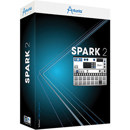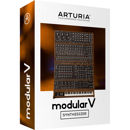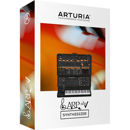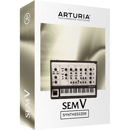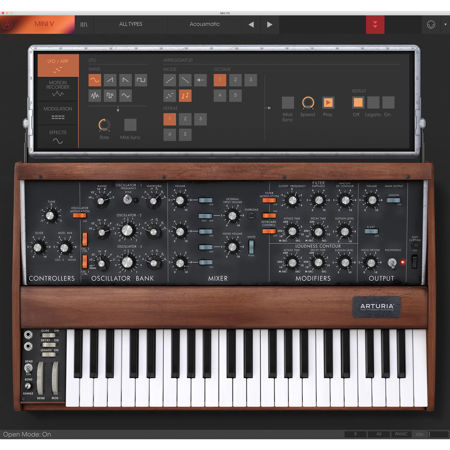
Arturia Mini V V3 Virtual Synthesizer Plug-In, Electronic Download
SKU: AR210502
This item is no longer available.
Recommended Alternatives
Share:
Overview
Compare
Specs
Q&A
Questions & Answers
Reviews about this item
Review Summary
2023-11-21T14:01:50
Rated 5 out of 5
The Model-D for the Future
The Arturia Mini V3 is incredibly cool. There is truly sooo much you can do over a standard Model-D from an extra LFO that doesn't eat up oscillator 3 to velocity as a modifier to varying actual pulse widths static or modulated to individual amounts of any modifier on each oscillator all made possible by the eight slot mod matrix. The major failing that I take no points off from this synth is that it does not have the natural drift of the original Model-D. I'm pretty sure I have heard & seen oscillator drift in soft software synths so I'm not sure why it's omitted here but as long as you detune your oscillators to taste you get a rich sound that in context will surpass a Minimoog in terms of sheer flexibility & enhancements every time. The built in chorus & delay sound good but really aren't necessary for most patches. I never found a use for the vocal filter as I would have preferred female articulations or the motion recorder as it always restarts with each note press & isn't free running like say a Moog 1125 which would have been an ingenious touch. Maybe in a future update. For sheer flexibility from enhancements such as polyphony & velocity to being able to automate sequences & performances to never needing to service your instrument the Arturia Mini V3 delivers in spades. I literally sold my vintage Model-D because the Mini V3's features made me feel the vintage instrument is more of a collectors piece & not forward thinking. I see myself using the Mini V3 for a long time to come.
Tom N.
Arturia Mini V V3 Specifications
System Requirements
Mac:
2 GHz CPU
OS X 10.8 or later
4GB RAM
1GB free hard disk space
OpenGL 2.0 compatible GPU
For plug-in use, host software that supports AAX Native, Audio Units, VST2.4, VST3 or NKS formats (64-bit DAWs only)
Windows:
2 GHz CPU
Windows 7 or later
4GB RAM
1GB free hard disk space
OpenGL 2.0 compatible GPU
For plug-in use, host software that supports AAX Native, VST2.4, VST3 or NKS formats (64-bit DAWs only)
About Arturia Mini V V3
FEATURED REVIEWS
The Model-D for the Future
By Tom N.
The Arturia Mini V3 is incredibly cool. There is truly sooo much you can do over a standard Model-D from an extra LFO that doesn't eat up oscillator 3 to velocity as a modifier to varying actual pulse widths static or modulated to individual amounts of any modifier on each oscillator all made possible by the eight slot mod matrix. The major failing that I take no points off from this synth is that it does not have the natural drift of the original Model-D. I'm pretty sure I have heard & seen ...
View full Review
Technology Meets History
From the starship funk lead lines of the '70s to the gangster whine of mid '90s hip-hop, the ever-present MiniMg has been making its fat presence known for over 4 decades. In partnership with Bob Moog we recreated the legendary interface of his early 70's synth that was and is loved by generations of musicians. What truly makes this synth the Legend of Legends is its sound and so we took great care to model the subtleties of its internal characteristics as well.
A good thing made better
Mini V has kept all of the original characteristics of its award-winning previous versions. Mini V version 3 updates the filter design to make it even more accurate than ever. Powerful and rich bass, faithfully reproduced 'free-running' waveforms thanks to new advances in our long proven TAE technology.
A class of its own
When fat, deep blistering bass is needed, there is no further need to go anywhere but to Mini V. Also famous for its powerful lead sounds, the greatest hit makers in the '70's knew that this synth was the goto tool.
A Sonic Expansion
But we're not resting on our laurels
While the original product set the sound of the 70's we have taken it to new realms. We have added an advanced modulator that allows you to draw a shape and control many parameters creating a movement and interest. A vocal filter expands sonic possibilities with a formant-analysis based effect: now you can make that synth talk! A modulation matrix has been added dramatically improving on the original design and doing away with its limitations.
A little bit of history.
The model of the Mini V knew an unparalleled success during the 1970's. Artists and bands like Tangerine Dream, Kraftwerk, Depeche Mode, Keith Emerson, Jean-Michel Jarre, Klaus Schulze and Rick Wakeman used the synthesizer, notably for the typical sound and its very warm quality, which is excellent for basses and lead sounds. The very first prototype of this synth was called Model A. Three other versions, B, C and D, followed. This last model is the final and most common incarnation of this synthesizer and the only one that was put into production in large numbers. The choice of wood rather than plastic for the cabinet prevailed from the beginning, simply because Robert Moog preferred to follow the advice of his musician friends rather than the drawings coming from his industrial engineers.
The Model D was first introduced at the NAMM convention in June 1971. It was Dr. Moog's first exposure to the musical instrument industry - and the industry's first exposure to synthesizers. The reception was rather cold as, according to Bob Moog himself, "Most dealers didn't know what to make of a musical instrument with words like Oscillator Bank and Filter printed on the front panel."
A faithful reproduction
The original synth had particular characteristics for which it is loved by musicians even to this day. Arturia mini V brings back the sound and features of this beloved synth in a virtual instrument. We decided to recreate the legendary interface of the original because of its "vibe", a look and layout known and loved by generations of musicians. But what truly makes this synth the Legend of Legends is its sound and so we took great care to recreate its internal characteristics as well.
Why does it sound so good
First, the oscillators. We recreate the exact characteristics of each oscillator, which have a very unique sound. And as with any discrete component analog oscillator, mini V produces free-running" waveforms lust like the physical circuits do. Secondly, the filter. Many digital filters have some characteristics which are very far from their analog counterparts The mini V filter has the same characteristics as that of the original synth. Le, its frequency and emphasis are completely independent The mini V filter is a true emulation of the renowned 24dB/octave 4-pole filter.
Another feature of the original filter is that the emphasis decreases when the cutoff frequency is low. This contributes a special character to the sound that lets the bass pass cleanly through the filter when playing lower nofes. The soft-clipping behavior of the original synth's amplification stages is also very important to the sound character, adding some Intriguing harmonics and making basses sound more powerful.
What we added
Making perfection better
While we were carefully modeling the characteristics of the sound, we also added some very imaginative options throughout the synth engine. To use the modulation matrix as an example, the Vocal Filter X and Y axes are available as independent destinations. There are two sources based on the Sample & Hold output and you can even use an audio track from your DAW as a source. Another example: you can use the voice number itself as a discrete source when in polyphonic mode, which can be a very interesting way to control a parameter.
Vocal Filter
Did you ever dream of making a synthesizer talk Well, we dreamed up a very exciting solution called the Vocal Filter. The sonic results can be spectacular, from digeridoos to interactive choirs, from sweet 'oohs' to the stuff of nightmares.
Automation
What if the original synth had offered automation - not as a control option, but as a sound design tool Pick up to four parameters and record realtime changes within the preset. This gives rise to an entirely new sound palette, even if only the original synth parameters are used.
Modulation Matrix
LFO/ARP
We added some very useful enhancements to the original synthesizer, of course - polyphony, for one thing and many other simple and powerful features. These are easily accessed through a dedicated panel in the mini V window. Wait, polyphony That was the dream of an entire generation of synth users! But that's part of the beauty of software-based synthesizers and we bring this modern capability to you with mini V.
We also added the following features, always with keeping in mind the simplicity of the original synth:
Delay & chorus
Simple parameters, but rich sound. The chorus was carefully engineered to have a "creamy" sound without blurring the natural attack transients of the synthesizer.
Modulation matrix
Provides up to 8 modulation routings constructed from your choice of 15 sources and 35 destinations.
LFO
An extra oscillator is available for modulation purposes. This frees the third oscillator to add further depth to the sound or be available as an independent source in the modulation matrix.
Arpeggiator
Hold a note or chord on your keyboard and they will repeat while playing arpeggios and transposing according to the settings you select.
PWM
The pulse width of any oscillator waveform can be modulated through the modulation matrix. This feature is unique to mini V and allows you to make sounds that were impossible on the original synth.
What you can do with the Mini V
You can make an insane range of sounds with mini V. Of course it is particularly adept at bass and lead sounds. And pads. And effects. And, well, everything. But if you ask owners of the original synth what sort of sound is its specialty, almost every single one would say "Bass!" And naturally it's used for bass and lead sounds since it is monophonic. But there's another reason: its simple but efficient voice architecture, the specific shape of the filter, the characteristics of oscillators and the soft-clipping output stage give the original synth a warm and unique sound. And Mini V reproduces this sound exactly, so it also excels at powerful, fat basses and lead instruments.
The lead sounds are also as clear and full as on the original, with the same glide and that very particular envelope response which makes each sound more playable. But there's more! With polyphonic capability, an arpeggiator, the modulation matrix and the effects, you can make an incredible array of sounds while still enjoying the simple layout and true character of the original voice architecture. Inserting a mini V sound into your mix is quick and easy. You can pick any one of over 1,000 presets, made by renowned sound designers and begin to play. All parameters are directly accessible, so you can tweak the sound easily to fit your song.
Preset browser
Our redesigned preset browser lets you quickly find just the sound you're looking for. Search by name or simply select the appropriate tags to dial in on the exact sonic character you're looking for. You can mark and recall your own favorites, enter comments and set up playlists. There's never been a more intuitive way to manage your library of designer and personal presets.
Resizable GUI
The user interfaces for all your Arturia instruments are now resizable, making it easy to work with any High Resolution screen, UHD or Retina. You can decide whether you want to fill the screen with awesome graphic reproductions of classic instrument goodness, scale the window down when you're working in a DAW and screen real estate is at a premium, or even zoom for detailed work.
Perfect integration
However you play, perform, or create, we've got you covered. We've made it as easy as possible to use and enjoy the instruments in V Collection 7. They intuitively map with the Arturia KeyLab range and play nicely with other MIDI controllers too. You can use them in standalone mode and in your preferred DAW. You can even play notes using your computer's keyboard when you're on the go!
Arturia Mini V V3 Features
- All the parameters of the original Mini V:
- 3 Voltage controlled oscillators with 5 waveforms
- 1 Amazing 24 dB/octave filter
- 2 ADSR envelopes
- LFO with 7 waveforms
- 1 Noise Generator
- 1 VCA
- 1 Mixer
- 1 External audio input and 1 external oscillator and filter modulation input
- Modulation matrix with up to 8 connections (15 sources and 35 destinations)
- Arpeggiator
- Vocal Filter: a fully automatable, formant-based effect with its own LFO
- Up to 32 voices of polyphony
- Unison mode option
- More than 450 presets created by an international team of top-notch sound designers
- Stereo effects: chorus and delay
- Soft clipping function
- Advanced automation mode
